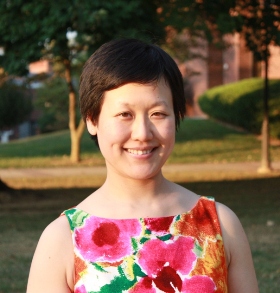Navigating the ever-changing world of Internet-based Health Communication
Yifeng Hu explores the eclectic offerings available through new media—from medical blogs and commercial websites, to 3D virtual worlds where people with disabilities communicate through avatars, to mobile apps that transmit dietary tips to shoppers as they cruise grocery store aisles. Her findings have implications for policymakers, medical professionals, and cure seekers.

Prof. Yifeng Hu
Until the digital era, the search for medical counsel often began and ended at the doctor’s office. But an expanding universe of health information, advice, and emotional support just a click away on the Internet now enriches—and complicates—the journey back to health for many cure seekers.

Communication Studies professor Yifeng Hu navigates this swiftly evolving world as she explores the eclectic offerings available through new media—from medical blogs, homepages, and commercial websites…to 3D virtual worlds where people with disabilities communicate through walking, talking avatars…to mobile apps that transmit dietary tips to shoppers as they cruise grocery store aisles.
“The amount of information out there is overwhelming, so how do we evaluate it? What fascinates me is how people determine what health information is credible and then act on it,” says Hu. In a recently published report, she conducted an experiment involving well over 500 people to determine how they appraised different sites offering similar information.
“What I found is that context matters. People differentiate between sources, even if they’re offering the same information. They tend to trust websites and forums they feel are collectively minded by gatekeepers—editors and moderators—more than an individual’s blog,” she says.
Her findings have implications for policymakers designing public health campaigns and doctors seeking an audience for their medical opinions, among others, notes Hu, who is also interested in new media’s potential to reduce health care costs.
Just as she studies the way people evaluate expert sources, she also explores their motivations for becoming experts themselves. In a recent project on mental health blogging, for example, she recruited 50 bloggers to answer survey questions about their reasons for writing public journals and the perceived benefits. There is no simple answer.
“They have a mission to help others with similar issues, to be less isolated themselves, and to advocate for issues,” she says, adding that she also learned from survey participants that “sharing with others and expressing creatively was positively related to perceived wellness, such as improving treatments, reducing dependency on drugs, reducing symptoms, physician visits, and time missed from work. This may be one advantage of writing blogs over private journals.”
Online communities, she observes, can be powerful social supports. “These groups have become so important in healing and recovery. The people closest to us in our social networks may not understand our problems as well.”
Hu is adept at bringing the world of new media to life in her classes. She regularly immerses students in her New Media and Health Communication seminar in the online virtual world “Second Life,” in which participants interact through avatars. She invites guest scholars to give lectures in classrooms that may on a given day be a high-ceilinged mountain lodge with a crackling fireplace and on another, a lecture hall that looks out on the ocean.
In keeping with TCNJ’s emphasis on hands-on, solutions-focused scholarship, her students approach new media as eager problem solvers, looking for the newest in medical training, disaster simulation modeling, and communications-enhancing programs for people with speech and other disorders.
In her class, they are expected to not just assess the current impact of emerging technologies on health communications, but to forecast the future of these applications as they consider careers in fields ranging from health marketing, to speech therapy, to public health policy and advocacy.
She dates her own interest in new media to her student days. After earning a bachelor’s degree in journalism from Renmin University of China in Beijing, she moved to Hong Kong to pursue a master’s degree in communications and was struck by the popularity of a then-new technology, instant messaging. While earning her PhD at Penn State University, she conducted a survey focused on the relationship between messaging and the level of perceived intimacy between friends. She found it promoted rather than hindered it, and was once a significant user herself, mostly to communicate with her family in mainland China. She has since moved on to Skype.
While technologies evolve, Hu says her students complain that their new media and health communication textbooks do not.
“They say, ‘These books are all old!’ And they’re right. This field changes so rapidly,” laughs Hu, who is now writing one. She’s also enlisted students to join her in a related project—to conduct an exhaustive review of new media and health communication research over the past five years.
“It is clear that technology is having an increased impact on how patients receive counseling and therapy, cope with various diseases and health concerns, and interact with physicians,” she says. “So the purpose of our study is to examine the status quo of research regarding the use of new media technology in health communications and propose tactics that can be explored by future researchers.”
Posted on May 7, 2012

